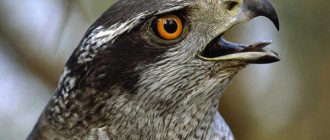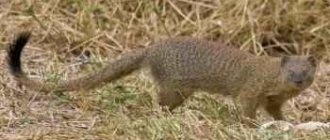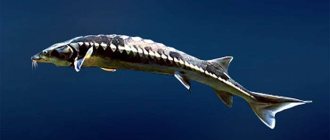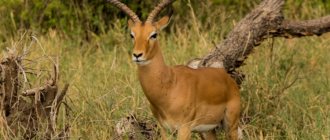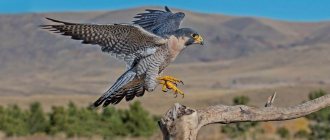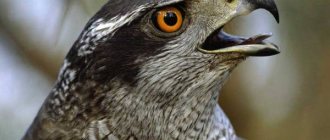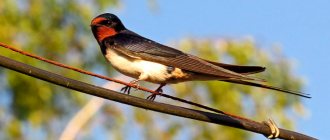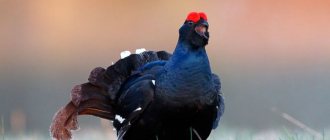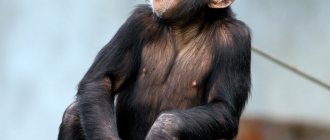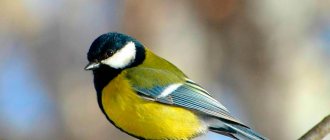The hawk is a bird of prey in the family Accipitridae of the order Accipitridae. It is found on almost all continents. The places where the hawk lives are different: mountains, plains, woodlands, jungles, savannas. Throughout their lives, these birds of prey stay in the same territory.
The goshawk is the largest representative of accipitridines.
What does a hawk look like and its lifestyle
Hawks are birds of prey with a body length of up to 72 cm and a weight of up to 1.5 kg. The largest of them is the goshawk, the smallest is the sparrowhawk with a body size of up to 32 cm and a weight of up to 115 g.
The bird's body is completely covered with feathers. Its beak is short and curved downwards. Above the beak is a cere, which is an area of skin with nostrils located on it. The predator's eyes are usually yellow or yellowish-orange. In some species, the color of the iris becomes lighter with age. The hawk has excellent vision, which is 8 times better than humans. Also, the eyes of predators are located in a special way: they are not on the side, but turned forward. Thanks to this, the hawk can see well. Birds have well-developed hearing, but they have little discernment of smells. The hawk's legs are strong, and the toes have long, curved claws.
Most hawks have a characteristic color: the upper body and head are often covered with dark gray or brown plumage, the belly and chest are lighter. It happens that even birds of the same species, but living in different habitats, have differences in the color of their feathers. For example, the goshawk, which lives in northeast Russia, differs from its relatives in its pure white plumage.
Unlike larger birds of prey, the hawk feels confident in wooded areas. He is able to move deftly in dense thickets, easily makes turns, lands sharply and takes off.
The hawk lives in the wild for 16–20 years; in captivity it can live longer.
What do hawks eat?
The hawk feeds mainly on birds; it also hunts small animals and insects. Individuals of certain species catch toads, lizards and snakes. Most of the prey consists of small birds: finches, titmice, wagtails, sparrows, turtle doves, woodpeckers and others. Predators also do not disdain field mice, rats, rabbits, hares, and squirrels. Among arthropods, birds catch dragonflies, locusts, cicadas, beetles, and grasshoppers.
When hunting, hawks soar at high altitudes and search for suitable prey. When they notice the victim, they wait for an opportune moment and suddenly attack. In flight, the hawk can deftly grab prey both on the ground and in the air. Having caught the victim, the bird squeezes it tightly with its paws and pierces it with its claws. It eats the bird or animal along with its feathers, fur and bones. The photo shows a hawk eating a tit.
Hawk eating a tit sitting on a tree
INTERESTING FACT. The sparrowhawk hunts differently. It does not hover in the air in search of prey, but quickly glides down using its open tail.
Most species of hawks are wintering birds. Only species living in northern latitudes migrate to warm regions. For example, predators from North America fly to Mexico for the winter. Sparrowhawks, which live in Russia in the summer, fly to North Africa or central and southern Asia for the winter.
In their natural environment, hawks do not have many enemies. Adults are sometimes attacked by larger birds of prey: eagles, eagle owls, owls, kites. Small mammalian predators, such as foxes or martens, can eat a hawk chick that has fallen from the nest. It happens that young birds become prey for adults.
How the hawks sing
Most hawks scream, but there is a separate genus of singing birds of prey that live on the African continent. They produce pleasant melodic notes, similar to the sound of a flute. Only gray, white and dark hawks can sing. The remaining representatives of the hawks make unpleasant, sharp sounds: some “croak”, others “scream”. Bearded hawks make unusual sounds - sometimes a soft whistle, sometimes something similar to a meow.
The call of a hawk is often used by hunters to scare away wild birds and find out their location. A special decoy is used for this, but some experienced hunters can independently imitate the voice of a predator.
We invite you to listen to how the hawks scream.
The basic Instinct
— Why is this rather unpleasant phenomenon necessary - aggression?
— In everyday speech, in politics and ethics, it is almost a dirty word. But for a psychologist, anthropologist or biologist, everything is not so simple. Aggression is a fundamental property of living things. Life requires energy, which is released when other organisms are destroyed. Hence the constant companions of life - competition, selection.
According to medical protocols, when a person is immersed in a diabetic coma, the last thing (after sexual, food) is the aggressive-defensive reflex is turned off. I will add that creativity, friendship, love, humor are in many ways transformed forms of aggression. And sex, by the way. Special literature provides amusing illustrations of the relationship between aggression, sex, humor and a sense of beauty. Here, for example, is the courtship ritual of one species of parrot: the male assumes a pose of extreme rage and... hangs upside down on a branch. Many experts believe that laughter evolved from a reoriented aggressive gesture.
— Is aggression a single phenomenon? Do you experience the same range of feelings during a hunt as during a war?
— Of course not. In psychology, two types of aggression are distinguished: hunting and affective. The wolf does not hate the hare. Fans of hunting or fishing will easily understand this. That’s why they talk about “the emotionlessness of a predator.” In the brain, the center of hunting aggression is located separately from the center of affective (or emotional) aggression, which is focused on fights between “friends,” between representatives of the same species. With hatred and malice towards our own kind, we fight for territory, for a female, for food. But emotional experiences are twofold: where there is hatred and anger, pity and sympathy for a relative are possible. Therefore, both types of aggression are involved in wars between people. For example, politicians often present opponents as “subhumans” in order to turn on the hunting instinct and stop remorse.
Range and habitat
The habitat of different species of hawks is very different. Goshawks live in North America, Europe, Russia, and Morocco. This numerous species of hawk is also found in Ukraine and Belarus. The African goshawk is distributed in central, eastern and southern parts of Africa. It is found in the mountains, near fields, forests and artificial plantings.
The sparrowhawk inhabits almost all of Europe and northeast Africa. In Asia it is found in the southwest of China. Light hawks live in the Australian forest-steppes. Songbirds are found in African forests and savannas south of the Sahara.
The crested hawk lives in southeast Asia. Red - found in the forest-steppe zones of north-eastern Australia. The endangered bearded vulture lives in regions of Southern Europe, East Africa and Central Asia, and is rarely found in the Caucasus and Altai. The white-tailed species inhabits Northern Europe, northwestern Africa and the territory of Russia. The white-tailed hawk is also found in Belarus.
Hawk on the snow with the remains of its prey
Video
And in conclusion, an interesting documentary about hawks from the National Geographic channel called “Goshawk - Phantom of the Forest.”
Author: Pavel Chaika, editor-in-chief of Poznavaika magazine
When writing the article, I tried to make it as interesting, useful and high-quality as possible. I would be grateful for any feedback and constructive criticism in the form of comments on the article. You can also write your wish/question/suggestion to my email [email protected] or Facebook, with respect, the author.
Author page
Types of hawks
Let's look at the features of the most famous species of hawks.
- The goshawk is distinguished by its large size; it can grow up to 72 cm in length with a wing size of up to 37 cm. Males are smaller than females. The birds have dark gray-brown plumage, the belly and crop are light with dense black streaks.
- The African goshawk has a length of 36–41 cm, the male weighs about 260 g, the female weighs about 350 g. The back and wings of the bird are covered with thick gray-brown feathers. The belly and chest are light with red spots.
- The sparrowhawk is small in size: the body length is 32–37 cm, and the weight is from 110 to 285 g. Representatives of this species are similar to the larger goshawk, only the stripes on its chest and abdomen usually have a red or brown tint.
- The crested hawk is colored typically for its species: the head and wings are dark, the belly and chest are light with black spots. The length of the body is 32–47 cm. A distinctive feature of the bird is a small crest in the lower part of the back of the head.
- The gray hawk is distinguished by a grayish coat with a blue tint and a white belly with dark stripes.
- The white hawk is completely covered with snow-white feathers.
- The dark song hawk is distinguished by the melodiousness of its sounds. Its body length is about 45 cm, its wings are longer than those of other hawks. The feather cover is dark gray on the back and head, lighter on the chest and belly. A striking feature of the song hawk is the base of its beak, which is scarlet in color.
- The red hawk has a body length of 47–62 cm, wingspan is about 118 cm. The male is smaller than the female. The body of the bird is covered with reddish-brown feathers. The head and neck are lighter with dark spots.
- The European tyuvik has an average body size, weight - from 150 to 230 g, wing length - 22-24 cm. The color of the plumage is rich dark brown, the belly is lighter with thick longitudinal stripes of a red color.
- The bicolor hawk is distinguished by its bright plumage: gray back and wings, light gray belly and breast. The feathers on the legs and under the wings are bright orange. The bird is also distinguished by large bulging yellow eyes.
- The white-tailed hawk is also quite large, body length - up to 90 cm, weight - up to 7 kg. Its body is covered with brown feathers, which are darker at the edges of the wings. The white tail of the bird clearly stands out against their background.
There are also rare species and those that are on the verge of extinction. This is the Cuban hawk, which is found only in the western part of Cuba. It is distinguished by its white and rufous plumage on its head and belly and has gray wings and tail. The largest representative of the hawks, the bearded hawk or lamb's hawk, is also a rare species. Its body length can reach 125 cm and weigh up to 7.5 kg. The bird has an unusual coloring: the wings and back are silver-black, the rest of the body is covered with red plumage. The photo shows a bearded hawk.
Bearded hawk on the rocks
Difference from a kite
Hawks are also confused with kites; below we will present the main differences between these birds.
- The kite has shorter and weaker legs compared to the hawk.
- The tail of a kite is strongly notched, while that of a hawk is rounded.
- The beak of a kite is more elongated and weaker than that of a hawk.
- But the wings of a kite, on the contrary, are longer than those of a hawk.
- The kite is not as skilled a hunter as the hawk; its diet usually consists of carrion, garbage, and sometimes it can even steal food from other birds of prey. The same cannot be said about the hawk, an excellent and skillful hunter.
Reproduction and care of offspring
Hawks are characterized by monogamy; they mate for life. They become sexually mature at the age of 1 year. Birds prefer to nest constantly in the same territory. If the old nest is preserved, the birds use it again. In other cases, hawks use other people's nests or build new ones. Construction of the nest usually begins 1.5 months before mating. Birds love to build nests in mixed, deciduous and coniferous forests on the treetops. Future parents use branches, leaves, and grass as building materials. Song hawks also use water mud.
Hawks produce one offspring per year. The female lays eggs in May for several days. A clutch usually contains 2–5 eggs of different colors. Some eggs may be brown, others blue-gray or light green. If a clutch dies, sparrowhawks may lay a new one. The female always does the incubation; the male feeds her during this period. The chicks usually hatch after 32–38 days. For the first 2–3 weeks after the birth of the offspring, the female remains in the nest, and the male brings prey for the family, which he gives to his partner. The female tears small pieces from the carcasses and feeds the babies. When the chicks grow up, both parents search for food. After the birth of the offspring, the female hawk becomes more aggressive. She may be the first to rush at an animal or person passing near the nest. The chicks leave the nest approximately 40 days after birth. Parents feed their offspring for about another 1.5 months.
INTERESTING FACT. It has been observed that adult pairs of hawks have 2–3 nests in their territory. In different years they choose one of them depending on external factors and weather conditions.
There were cases where hawks raised the nest higher and higher every year. The reason was outside interference. Ornithologists also claim that the number of eggs in clutches is gradually decreasing - this is due to the deterioration of the environmental situation. Egg viability has also decreased in recent decades.
We invite you to watch a video about how a sparrowhawk takes care of its chicks.
What is the difference between a hawk and a falcon?
Hawks and falcons belong to different families. Falcons are larger in size; the weight of adult individuals reaches 1.3–2 kg. Their wings are pointed at the ends and narrower, rather than rounded and wide, like those of hawks. Falcons also have a pronounced tooth on the beak and a longitudinal ridge on the roof of the mouth. Their eye color is usually dark brown.
Hawks and falcons have different habitats. The former prefer to live in forest-steppe zones and look out for prey among the trees. Falcons live in steppes and open spaces. Birds kill prey in different ways: hawks strangle it and pierce it with their claws, falcons rip apart the body with their claws and finish off the animal or bird with their beak.
On the left is a falcon, on the right is a hawk.
Keeping a hawk in captivity
People keep hawks as an exotic pet, or less often for sport hunting for game birds.
Proper keeping of a hawk at home means giving the bird a whole room with enough space to fly, or a spacious enclosure. In a private house, the second option is preferable. The aviary should be placed in a quiet place away from poultry and livestock. The structure can be made of a wooden frame, covered on three sides with burlap or canvas, and on the fourth with a lattice of slats 2 cm thick. The roof should be made of metal fine mesh, below which a nylon fishing net is stretched. This is necessary so that the hawk does not injure itself by hitting the ceiling in fright.
If the hawk lives on the balcony, it is necessary to cover its walls with burlap, remove the glass and replace it with wooden panels made of slats.
Hawks in captivity need to be fed natural food. Raw meat alone will not provide the bird with the necessary nutrients. She must eat the whole carcass so that wool, feathers, and bones get into the stomach. To do this, you will have to buy mice or hamsters for the bird at a pet store or from breeders. Chicks can be fed with minced meat.
Once in new conditions, hawks experience stress and may not touch food for a long time. Then you need to force feed them, bringing food on a stick close to the beak. You also need to make sure that the bird swallows the food. Gradually, the hawks will get used to humans and will eat on their own. Hawks drink little, but love to swim. Therefore, you need to give them a deep container for bathing and remove it after bathing.
HELPFUL INFORMATION. You should not feed your pet hawk large poultry or rabbits, as their meat contains too much fat.
In captivity, hawks practically do not reproduce naturally. Typically, a grown-up chick perceives its owner as a partner and does not mate with its own kind. Sometimes the female can behave aggressively towards the male and even kill him. More often in captivity, offspring are obtained through artificial insemination, which is quite troublesome and requires considerable investment in equipment.
Domesticated hawk on a bench
Taming and caring for a baby hawk
It is important to note that wherever you get a hawk, you must obtain a permit to keep a bird of prey from the Ministry of Environmental Protection. You can then purchase a captive-bred bird or find a hawk's nest and take the chick from there. In any case, for home keeping you should take a young hawk, which will quickly get used to the owner and easily adapt to new conditions.
Before bringing the bird home, you should prepare a place for it in advance. Then you need to find the hawks' nest, but it is better not to approach it until the chicks appear. Sometimes females, sensing danger, abandon incubation of the eggs. When offspring appear, the parents will not abandon the nest. It is better to take a chick that has reached the age of 8–14 days. At the age of one week, babies are already able to shed pellets - undigested bones and skin of victims.
The chick will need to be fed up to 5 times a day. Young birds should be given fresh carcasses of sparrows, pigeons, rooks and other common bird species. Part of the diet may consist of frozen meat, which has been in the freezer for no more than 2 weeks. Day-old chicks will help diversify your diet.
HELPFUL INFORMATION. Before the next feeding, be sure to ensure that there are no food residues in the crop. Usually all food is digested by a hawk in 4–6 hours. The following feeding regimen is suitable for this predator:
- 7:00–8:00 hours;
- 13:00–14:00 hours;
- 1 hour before dark.
A hungry hawk can eat a double portion of food. In this case, the next feeding should be postponed.
If the hawk refuses to eat, it is recommended to wait for a while and then offer food again. The cause may be an undiscarded pellet, too fatty meat, or hot weather. Prolonged starvation of the chick will negatively affect the formation of its breasts and the quality of its plumage. Scientists' observations showed that in cool years, young hawks grew up with wider chests than those born during hot summers.
Hawk populations and their benefits in nature
Unfortunately, the number of hawks is gradually declining. Even the numbers of such common species as the goshawk and sparrowhawk have been declining over the years. Hunting them is prohibited by the international convention CITES. The main reasons for the decline of hawks throughout the planet are environmental problems and human destruction of the natural habitat of these birds.
In the first half of the 20th century, hawks caused some damage to hunting grounds and were mercilessly exterminated. But this led to a reduction in the number of game animals and birds. It turned out that the feathered predators predominantly destroyed sick animals. This improved the gene pool and maintained the quality of populations at a high level.
White hawk on a branch
Diet
Mostly animal food . Chicks and young predators feed on larvae, frogs, and small animals. But older individuals prefer larger prey: hares, rabbits, pheasants, rats, mice, etc.
Hawks hunt more often during the day . These birds always have a clearly thought out hunting plan. According to which, the victim is almost always taken by surprise, which ends successfully only for the hawk. The feathered hunter keeps watch, then sharply and quickly attacks, grabbing the prey with its sharp claws, squeezing it and eating it. An interesting fact is that the anatomical structure of the hawk’s stomach in the form of a “bag” allows it to store the food it eats and, accordingly, eat about once every two days.
Interesting facts about hawks
The hawk is a very interesting and beautiful bird, but people know little about its lifestyle. Here are the most interesting facts about hawks.
- In North America, hummingbirds like to settle near hawk nests. They feel protected from their direct enemies, jays and squirrels.
- Hawks were often used to hunt pheasants and quail.
- In Japan, feathered predators do not disdain bats.
- Hawks in the city are used to protect landmarks from crows and pigeons, which stain them with their caustic droppings.
- Sometimes a hawk, grabbing prey, concentrates so much on it that it may not notice obstacles in its path.
- With a lack of food, hawks can kill and eat their weaker relatives.
- Goshawks do not eat crows. But in order to scare them away from their nest, birds sometimes kill several birds and throw their dead bodies nearby as a warning to others.
- The hawk is the hero of many sayings, songs and poems.
- To preserve crops, people often use a stuffed hawk to scare away birds.
Attitudes towards hawks among different peoples
For many peoples, the hawk is considered a symbol of fortitude, power and dexterity. But at the same time, the bird is associated with threat, darkness, death. Among pagan tribes, the hawk was the messenger of the Sun. People believed that a bird could fly to the star without blinking and without fear of its light. In Russian legends and epics, the hawk was often represented as a symbol of danger and military aggression. It is believed that the name of the bird comes from the words str - speed of reaction, flight, and reb - motley.
In Ancient Egypt and Rome, the hawk was considered the messenger of Apollo and the bird of the sorceress Circe. In Scandinavian countries, this bird was the embodiment of the supreme god Odin. Galicians and some peoples living on the territory of Poland considered the hawk a devil.
To protect poultry from predators, various amulets were made. There were many signs and beliefs associated with this. For example, the Poles believed that to prevent a chicken from being carried away by a hawk, its first egg should be given to a poor man. Belarusians believed that you should not burn an old broom, otherwise a bird of prey will start dragging ducks and chickens.
Natural enemies
The main enemies of the hawk are man and his unbridled economic activity. Weak and young birds can be waylaid by ground predators, including martens, foxes and wild cats. In the air, the threat comes from birds of prey such as the eagle, owl, buzzard and eagle owl. We must not forget that young hawks often become victims of their older relatives.
